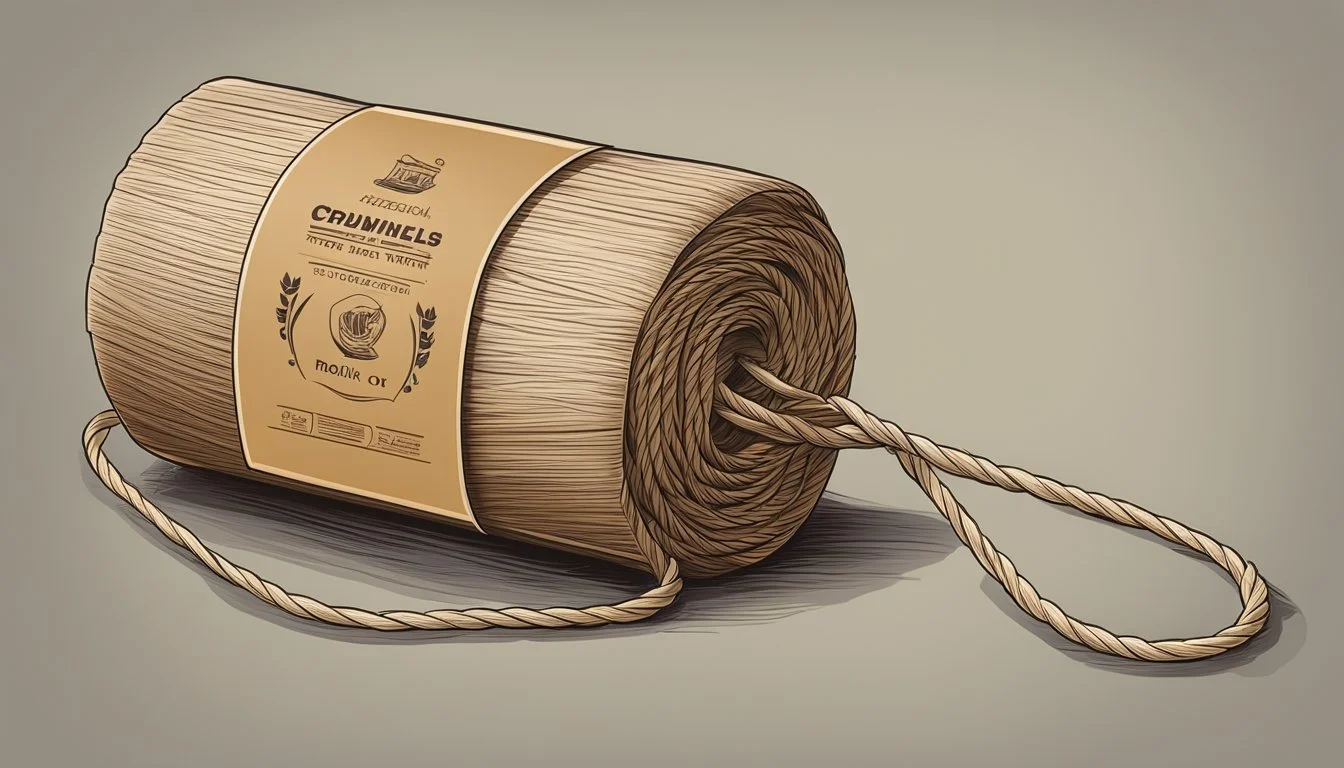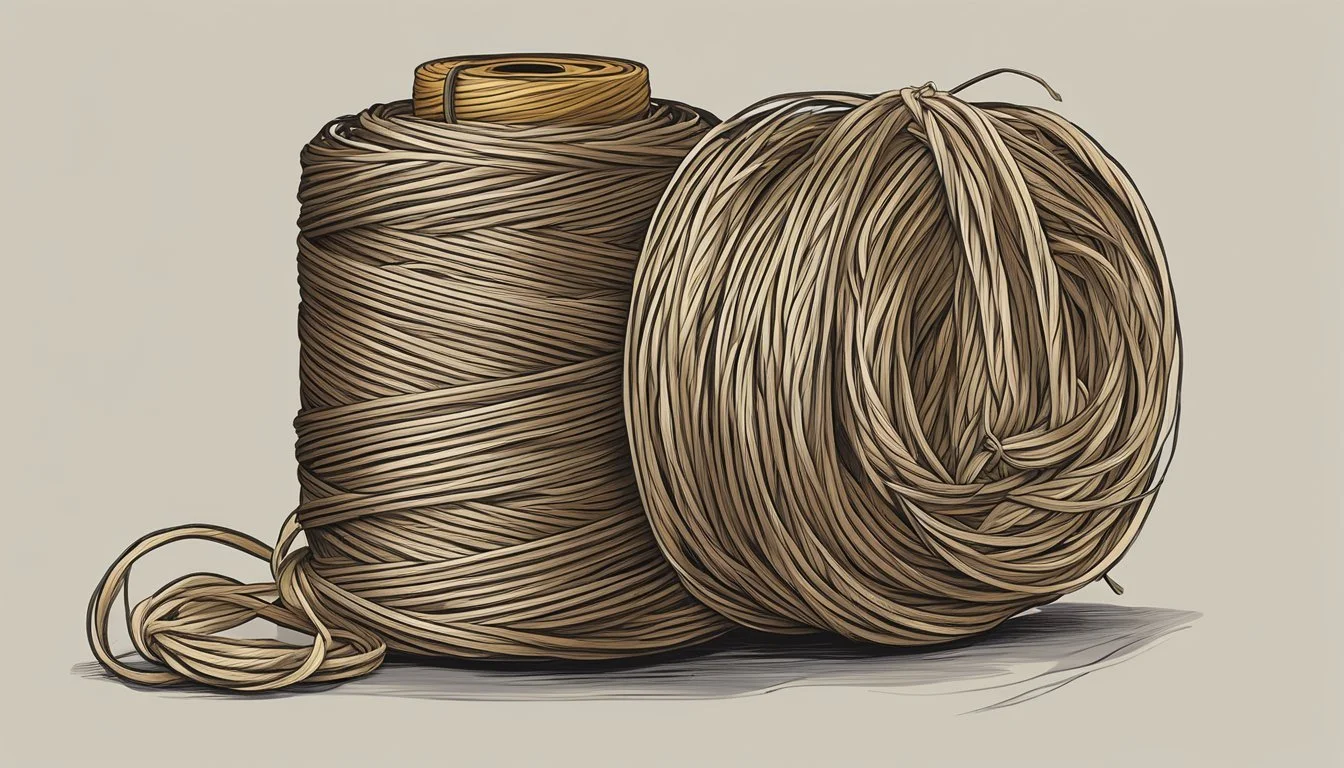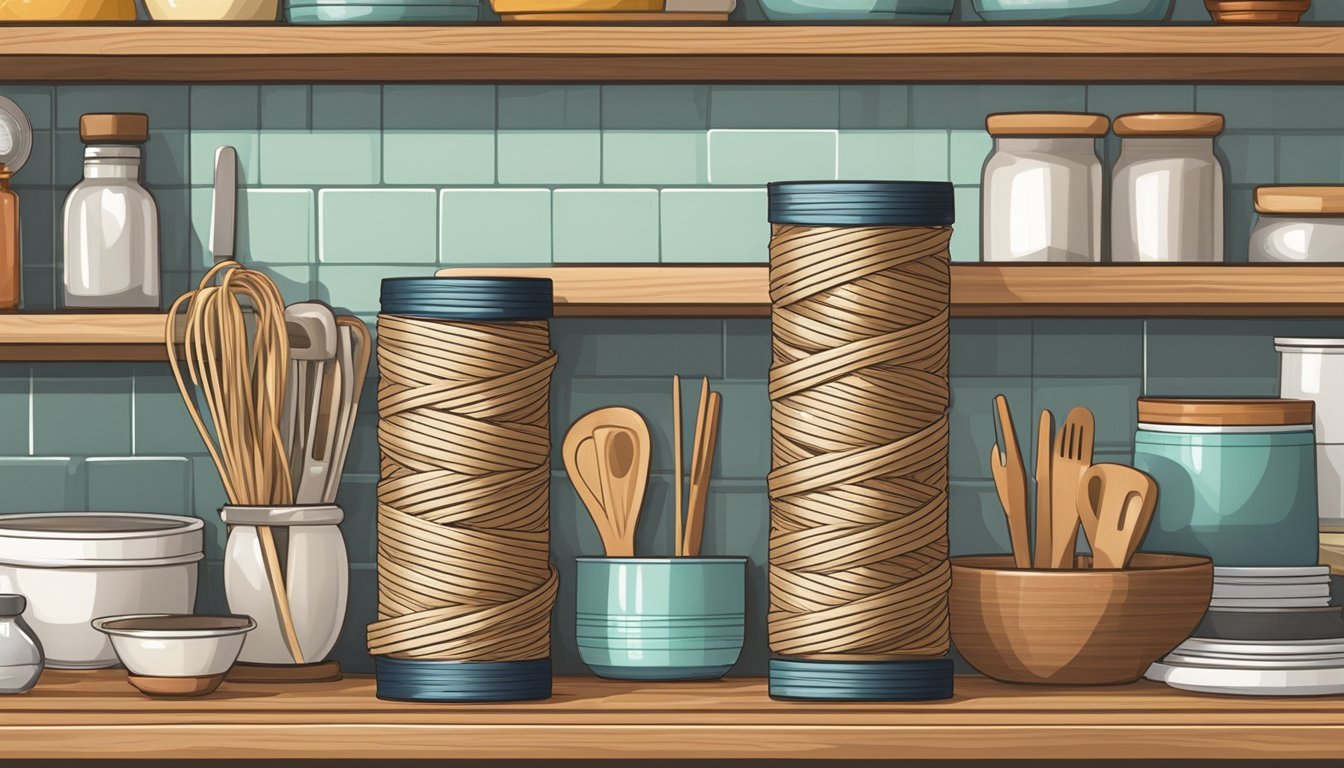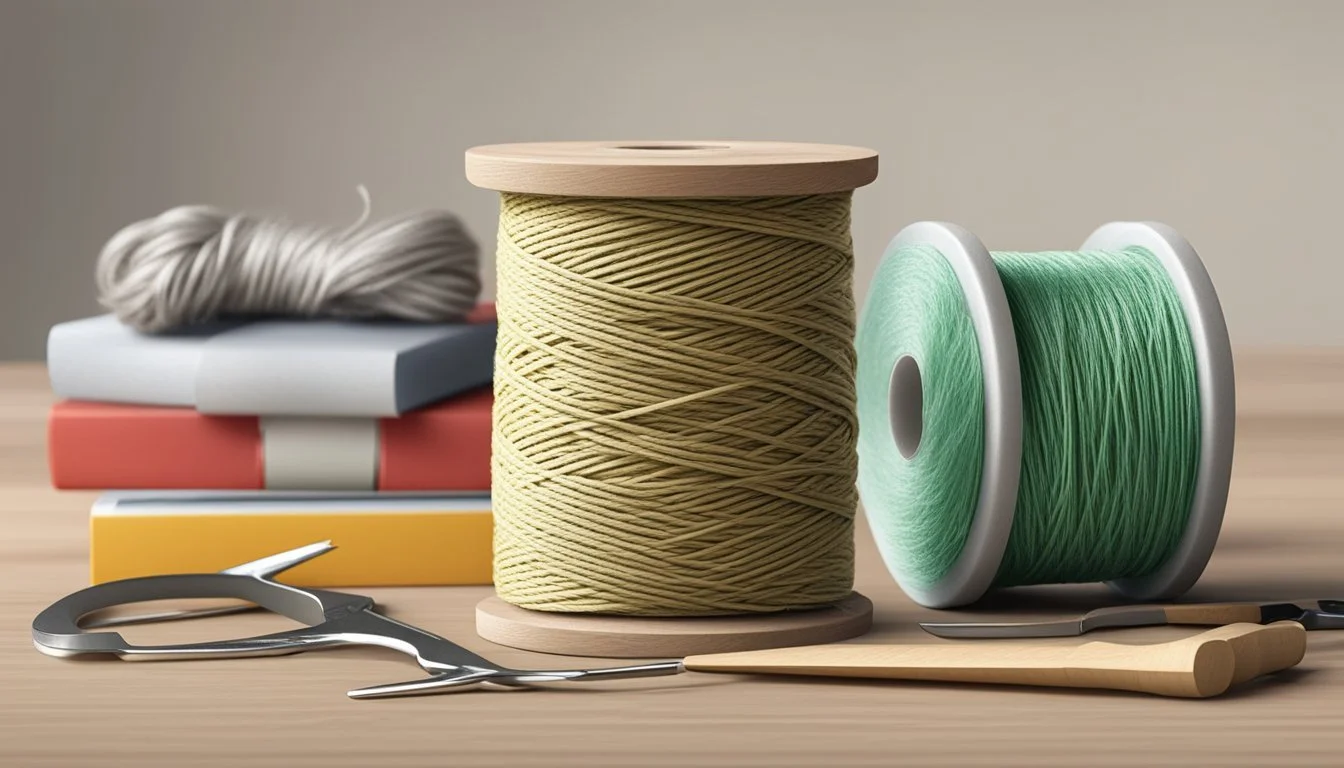The Essential Guide to Cooking Twine
Types, Uses, and Best Picks
Cooking twine is an essential kitchen tool that can elevate your culinary creations. This simple yet versatile string serves multiple purposes in food preparation, from trussing poultry to shaping roasts. Made from food-safe cotton, cooking twine helps maintain the shape of meats during cooking, ensuring even heat distribution and a more attractive presentation.
Chefs and home cooks alike rely on kitchen twine for various tasks. It can be used to bundle herbs, secure stuffed meats, and tie vegetables together for steaming. The strong, heat-resistant nature of cooking twine makes it ideal for use in high-temperature cooking methods like roasting and grilling.
While cooking twine is readily available in most kitchens, there are alternatives for those who find themselves without it. Dental floss, aluminum foil, or even wooden skewers can serve as substitutes in a pinch. However, the versatility and reliability of proper cooking twine make it a worthwhile addition to any kitchen arsenal.
Cooking Twine Basics
Cooking twine is an essential tool in the kitchen, used primarily for trussing and tying various foods during cooking. It comes in different materials and types, each with specific properties suited for culinary applications.
Definition and Types
Cooking twine, also known as kitchen twine or butcher's twine, is a string designed specifically for use in food preparation. It typically comes in two main types: natural fiber and synthetic. Natural fiber twines are most commonly made from cotton, but can also include linen, hemp, or jute. Synthetic twines often use materials like polypropylene or polyester.
Cotton twine is the most popular choice for cooking due to its versatility and safety. It's strong enough to hold foods securely, yet soft enough not to cut into meats. Synthetic twines offer durability but may not be suitable for all cooking methods.
Material Considerations
When selecting cooking twine, material is a crucial factor. Natural fibers like cotton are biodegradable and eco-friendly. They're also absorbent, which can be beneficial for some cooking techniques.
Synthetic materials offer advantages in strength and resistance to moisture. However, they may not be suitable for high-heat cooking methods. Some synthetic twines are treated to be food-safe and heat-resistant.
Linen and hemp twines provide excellent strength and durability. They're less common than cotton but offer similar benefits for cooking applications.
Heat Resistance and Safety
Heat resistance is a critical property of cooking twine. Cotton twine is generally oven-safe and can withstand high temperatures without melting or releasing harmful chemicals. It's important to use twine labeled as food-safe to avoid any potential contamination.
Synthetic twines vary in heat resistance. Some are designed to be oven-safe, while others may melt or release chemicals when exposed to high temperatures. Always check the manufacturer's recommendations before use.
Natural fiber twines can be flammable, so care should be taken when using them near open flames. However, they're generally safe for most cooking methods, including roasting and braising.
Preparation and Usage
Proper preparation and usage of cooking twine are essential for achieving optimal results when trussing meats and poultry. The right techniques and tools can significantly impact the cooking process and final dish presentation.
Trussing Techniques
Trussing helps create a compact, uniform shape for even cooking. Start by placing the meat or poultry breast-side up. For poultry, tuck the wings under the body. Cut a long piece of twine, about 4-5 times the length of the bird or roast.
Begin at the neck, leaving a tail of twine. Loop around the wings and bring the string down to the legs. Cross the legs and tie them together. Pull the string back up towards the neck, creating a tight package.
Tie off the twine securely, trimming any excess. For larger cuts of meat, create a series of evenly spaced loops along the roast's length.
Choosing the Right Twine Size and Strength
Select twine based on the size and weight of your meat or poultry. Thinner twine (1/16 inch) works well for small to medium cuts. Thicker twine (1/8 inch) is better for large roasts or turkeys.
Consider the cooking method. High-heat roasting requires stronger twine to withstand prolonged exposure. For gentler cooking methods, lighter twine suffices.
100% cotton twine is versatile and food-safe. Avoid synthetic materials that may melt or release chemicals during cooking.
Test the twine's strength by giving it a firm tug before use. It should resist breaking but not be overly thick or difficult to tie.
Alternative Trussing Methods
For quick trussing, use silicone bands or cooking-safe rubber bands. These are reusable and easy to apply, ideal for smaller cuts of meat or individual portions.
Toothpicks offer a simple solution for securing stuffed meats or rolled roasts. Soak wooden toothpicks in water before use to prevent burning.
Unflavored dental floss can substitute for cooking twine in a pinch. It's strong and thin, making it easy to tie tight knots.
Metal skewers provide sturdy support for large roasts or whole poultry. They're particularly useful for keeping stuffed meats closed during cooking.
Consider using specialized trussing needles for a professional finish. These long, curved needles allow for precise stitching of cuts or cavities.
Culinary Applications
Kitchen twine serves numerous purposes in cooking, enhancing both functionality and presentation. Its versatility makes it an essential tool for chefs and home cooks alike.
Roasts and Oven Use
Kitchen twine plays a crucial role in preparing roasts and oven-cooked meats. Trussing meats with twine helps maintain shape during cooking, ensuring even heat distribution. This technique is particularly useful for large cuts like beef roasts or whole poultry.
Tying a roast creates a uniform shape, promoting consistent cooking throughout the protein. For stuffed chicken breasts, twine secures the filling, preventing it from spilling out during the cooking process.
Professional chefs often use twine to bind herbs to roasts, infusing flavors directly into the meat as it cooks. This method enhances the overall taste and aroma of the dish.
Tying Herbs and Bouquets
Twine is indispensable for creating herb bouquets, also known as bouquet garni. These bundles of herbs are tied together and added to soups, stews, and broths for flavor.
Chefs use twine to secure fresh herb sprigs, making them easy to remove before serving. This technique allows for maximum flavor infusion without leaving loose herbs in the final dish.
For larger batches, twine can be used to create sachets filled with whole spices or dried herbs. These sachets are easily removed after cooking, simplifying the seasoning process.
Additional Kitchen Uses
Beyond meats and herbs, kitchen twine has various other applications in cooking. In baking, it's used to shape certain types of bread and pastries, creating decorative patterns or maintaining specific forms.
Twine helps secure parchment paper to baking pans, ensuring even coverage when blind baking pie crusts. It's also useful for tying up vegetables like asparagus or leeks before grilling or roasting.
In seafood preparation, twine can bind shellfish like lobster tails to prevent curling during cooking. For presentation, chefs use it to tie garnishes or secure food items on serving platters.
Advanced Techniques
Cooking twine enables sophisticated culinary methods that enhance flavor, texture, and presentation. Skilled use of twine can transform ordinary dishes into gourmet creations.
Meat Shaping and Presentation
Twine excels at shaping irregular cuts of meat into uniform shapes. This technique ensures even cooking and improves presentation. For beef tenderloin, wrap twine at 1-inch intervals to create a cylindrical shape. This maintains the meat's form during cooking and slicing.
Butterfly cuts can be rolled and tied to create pinwheels. This method works well for stuffed meats, allowing flavors to meld during cooking. Tie roasts tightly to prevent stuffing from escaping.
For poultry, trussing keeps wings and legs close to the body. This promotes even cooking and a compact shape for easier carving. Use a figure-eight pattern around the legs and wings for secure trussing.
Affixing and Cooking with Bacon
Twine secures bacon strips to meats, infusing flavor and moisture. Wrap bacon around lean cuts like pork tenderloin or chicken breast. Tie at intervals to keep bacon in place during cooking.
For beef filet, create a bacon weave. Lay bacon strips in a crosshatch pattern, then wrap around the meat. Secure with twine to maintain shape at high temperatures.
Bacon-wrapped scallops benefit from twine. It keeps bacon in place and allows even cooking of both components. Remove twine before serving for an elegant presentation.
Creating Compact Items for Smoking and Drying
Twine is crucial for preparing meats for smoking and drying. It creates dense, uniform shapes that promote even curing and smoking.
For homemade sausages, use twine to link individual sausages. This allows proper spacing in smokers and drying racks. Tie loops at regular intervals for easy hanging.
When making prosciutto or other dry-cured meats, twine helps maintain shape during the long curing process. Wrap tightly in a spiral pattern from top to bottom. This prevents air pockets and ensures consistent drying throughout the meat.
For smaller items like jerky strips, use twine to hang pieces in smokers. This allows proper air circulation and even smoke exposure.
Maintenance and Storage
Proper care and storage of cooking twine ensures its longevity and readiness for use. Clean, dry storage and sustainable practices contribute to efficient kitchen operations.
Cleaning and Storing Twine
Cotton and linen twines can be washed in warm, soapy water and air-dried completely before storage. Synthetic twines are easier to clean, often requiring just a quick wipe.
Store twine in a cool, dry place away from direct sunlight. A dedicated drawer or wall-mounted dispenser keeps twine tangle-free and easily accessible.
For compact storage, wind twine around a spool or cardboard tube. This method prevents knots and maintains the twine's strength.
Consider using airtight containers to protect natural fiber twines from moisture and pests. Proper storage extends the life of twine and maintains its quality for future use.
Reusable Options and Sustainability
Reusable twine options include strong, multi-ply cotton or linen varieties. These natural fibers withstand multiple uses and washings, reducing waste.
Synthetic twines, while not biodegradable, offer durability for repeated use. Their strength allows for multiple applications before replacement is necessary.
Eco-friendly alternatives like hemp or jute twines provide biodegradable options for environmentally conscious cooks. These natural fibers offer comparable strength to cotton.
Consider investing in silicone bands or adjustable stainless steel ties as non-twine alternatives. These reusable options are easy to clean and store, offering a sustainable choice for trussing and tying in the kitchen.
Purchasing and Quality Considerations
Selecting the right cooking twine involves assessing quality, materials, and reliable sources. Careful consideration of these factors ensures you get a product that meets your culinary needs.
Selecting High-Quality Twine
High-quality cooking twine is typically made from 100% cotton. This natural fiber is food-safe and heat-resistant, making it ideal for kitchen use. Look for twine labeled as "butcher twine" or "kitchen twine" to ensure it's suitable for cooking.
Quality twine should be strong and durable. It shouldn't fray easily or leave fibers on food. The thickness of the twine matters too - thicker twines are better for larger roasts, while thinner ones work well for delicate tasks.
Some twines come with a wax coating. This makes them more resistant to moisture and heat, but ensure the wax is food-grade. Uncoated cotton twine is versatile and can be used for both cooking and non-cooking purposes.
Identifying Reliable Brands and Retailers
Reputable kitchenware brands often produce high-quality cooking twine. Check reviews and ratings from other cooks to gauge product satisfaction. Established brands typically maintain consistent quality standards.
Many online retailers offer a variety of cooking twines. Look for detailed product descriptions that specify the material, length, and intended use. Some sellers package twine with butcher paper or wrapping paper, offering good value for home cooks.
Specialty kitchen stores and butcher shops are excellent sources for quality twine. These outlets often carry professional-grade products. Buying in bulk can be cost-effective for frequent users.
When purchasing, check the packaging for certifications or food-safety statements. This information helps ensure the twine meets health and safety standards for culinary use.
Safety and Regulations
Food safety is paramount when using cooking twine. Proper materials and handling techniques help prevent contamination and ensure dishes are prepared safely.
Understanding Food Safety Standards
Food-safe cooking twine meets strict regulatory requirements. It's made from natural fibers like cotton that don't leach chemicals into food. Heat-resistant twine withstands high oven temperatures without melting or burning.
Reputable manufacturers test their products to comply with food contact standards. Look for twine labeled as food-grade or food-safe. Avoid using regular household twine, which may contain unsafe dyes or treatments.
Kitchen twine is typically unbleached to prevent chemical transfer. Some varieties have a light wax coating that helps it stay tied and resist fraying. This coating is food-safe and designed to withstand cooking temperatures.
Avoiding Harmful Materials
Synthetic twines like nylon or polyester are not suitable for cooking. These materials can melt, releasing potentially toxic fumes. Jute twine should also be avoided, as it's often treated with oils or chemicals that aren't food-safe.
Natural fiber twines made from cotton or linen are the safest options. These materials are non-toxic and won't alter food flavors. They're also biodegradable, making them more environmentally friendly.
Fire safety is another important consideration. While cooking twine is generally not highly flammable, it can burn if exposed to direct flame. Always keep twine away from open flames and follow proper cooking techniques to minimize fire risks.
Alternative Uses Outside Cooking
Cooking twine's versatility extends far beyond the kitchen. Its strong yet flexible nature makes it useful for various non-culinary applications in everyday life.
Crafts and Decorations
Cooking twine serves as an affordable and versatile material for crafting projects. It's ideal for macrame, creating intricate wall hangings and plant holders. Crafters use it to make rustic wreaths, tying bundles of dried flowers or herbs for a natural look. The twine adds texture to homemade cards and scrapbook pages. It's perfect for wrapping gifts, giving packages a charming, eco-friendly appearance.
For holiday decorations, cooking twine can suspend ornaments or create garlands. Its neutral color complements many decor styles. Crafters often dye the twine for colorful projects or leave it natural for a minimalist aesthetic.
Gardening and Packaging
In the garden, cooking twine proves invaluable. Gardeners use it to train climbing plants, securing vines to trellises or stakes. It's useful for tying up tomato plants or creating supports for heavy fruit-bearing branches.
For packaging, the twine offers a reusable alternative to tape or rubber bands. It's excellent for bundling newspapers or securing parcels. Businesses often use it to tie branded tags to products, enhancing presentation.
Cooking twine also helps in organizing. It's useful for binding rolls of wrapping paper or keeping extension cords tidy. In workshops, it can temporarily hold pieces of wood together during gluing.
Binding Papers and Materials
Cooking twine excels in binding various materials. It's perfect for creating handmade books, securing pages together before sewing. Artists use it to bind sketchbooks or create unique journals.
In offices, the twine can bundle documents or secure file folders. It's useful for archiving, tying stacks of old papers or magazines. Libraries sometimes use it to repair book bindings temporarily.
For temporary fixes, cooking twine can hold broken furniture parts together until proper repair. It's also handy for bundling kindling for fireplaces or outdoor fires. In emergencies, it can even serve as a makeshift shoelace or belt.







